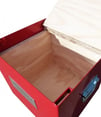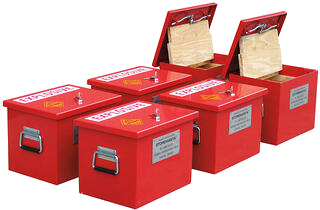The storage requirements for Class 1: Explosives can vary enormously, depending on the type of explosive being stored and its intended use.
In Australia, explosives are used extensively in a variety of diverse industries, from mining, oil and gas, construction, defence, and rail transport to marine, aviation, automotive, pyrotechnics (fireworks), and forensics.
Explosives are typically stored in an explosives storage cabinet or inside an explosives storage day box if they are being transported from one site to another for use.
An explosives storage day box used for safely moving Class 1 Explosives across worksites
This post provides a complete guide to the safe and secure storage of explosives and pyrotechnics in cabinets and day boxes as outlined in the Australian Standard AS 2187.1-1998 Explosives - Storage, transport and use, Part 1: Storage.
How is the Storage of Explosives Regulated?
Standards Australia publish a series of standards relating to the storage, transport and use of explosives and pyrotechnics.
The Australian Standard, Explosives - Storage, transport and use, Part 1: Storage (AS 2187.1-1998), sets out the requirements and precautions for the storage of explosives, including pyrotechnics as defined in AS 2187.0 (Terminology), and for the location, design, construction and maintenance of magazines (explosives stores).
The Standard applies to:
- Portable magazines
- Relocatable magazines
- Fixed or permanent magazines
- Bulk storage
- Underground storage
NOTE: The Standard does not apply to the storage of explosives and explosive ordnance for defence purposes.
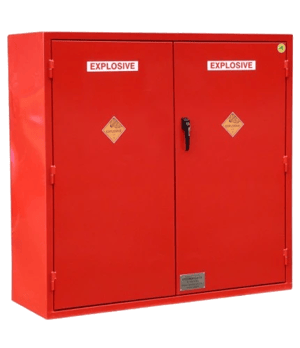 An explosives storage cabinet with compliant Class 1 Explosives warning placards and safety signage
An explosives storage cabinet with compliant Class 1 Explosives warning placards and safety signage
How are Class 1 Explosives Classified?
The Australian Dangerous Goods (ADG) Code divides Class 1: Explosive substances and articles into six (6) subdivisions, depending on the type of hazard they present
- Division 1.1 Substances and articles which have a mass explosion hazard (a mass explosion is one which affects almost the entire load virtually instantaneously)
- Division 1.2 Substances and articles which have a projection hazard but not a mass explosion hazard
- Division 1.3 Substances and articles which have a firehazard and either a minor blast hazard or a minor projection hazard or both, but not a mass explosion hazard
This division comprises substances and articles:
- which give rise to considerable radiant heat; or
- which burn one after another, producing minor blast or projection effects or both.
- Division 1.4 Substances and articles which present no significant hazard
- This division comprises substances and articles which present only a small hazard in the event of ignition or initiation during transport. The effects are largely confined to the package and no projection of fragments of appreciable size or range is to be expected. An external fire will not cause virtually instantaneous explosion of almost the entire contents of the package.
- Division 1.5 Very insensitive substances which have a mass explosion hazard
- This division comprises substances which have a mass explosion hazard but are so insensitive that there is very little probability of initiation or of transition from burning to detonation under normal conditions of transport.
- Division 1.6 Extremely insensitive articles which do not have a mass explosion hazard
- This division comprises articles which predominantly contain extremely insensitive substances and which demonstrate a negligible probability of accidental initiation or propagation.
NOTE: The ADG Code sets out the requirements for transporting dangerous goods by road or rail. The code and associated legislation do NOT cover the transport of Class 1 Explosives per se.
- The transport of Class 1 Explosives by road or rail in Australia is subject to the Australian Explosives Code and separate State and Territory legislation.
- However, subject to that legislation, when other dangerous goods are being transported with Class 1 dangerous goods, the segregation requirements of Part 9 (Incompatible Goods) of the ADG Code may apply (as per relevant State and Territory legislation).
- For transportation purposes, Class 1 Explosives are incompatible with all other dangerous goods in all quantities except as provided in the Australian Explosives Code or for Division 1.4S.
Dangerous Goods List of Class 1 Explosives
The ADG Code includes a list of dangerous goods of Class 1 Explosive substances or articles, providing references to special provisions and packing requirements.
The Dangerous Goods List is based on the definitive list from UN Model Regulations (Rev. 21, 2019), and is sorted by UN Number. An alphabetical listing is also provided.
The Dangerous Goods List includes each substance or article’s:
- UN Number
- Name and Description
- Class or Division
- Subsidiary Hazard
- Packing Group
- Quantities (Limited and Excepted )
- Special Provisions and other instructions where required
The list includes all Class 1 Explosive substances and articles covered by Australian regulations, from UN No. 0004 (Ammonium Picrate) to UN No. 0513 (Electronic detonators).
What are the Design Requirements for Explosives Stores?
AS 2187.1 sets out the requirements for the location, design, construction and maintenance of the magazines.
In terms of the siting of explosives storage, particularly outdoors, the standard mandates that consideration be given to public risk, security, access, protection from natural phenomena, drainage, reduction of fire risk, as well as lighting, lightning protection, mounding and fencing where required.
What are Class 1 Explosives Signage Requirements?
The Standard also stipulates the requirement for marking on magazine doors, including Class 1 labels and appropriate wording in red lettering on white background - such as:
- EXPLOSIVE
- DETONATORS
- FIREWORKS
- STAGE PYROTECHNICS
- PROPELLANT POWDERS
- BLACK POWDER
- DISTRESS SIGNALS
Any storage facility containing Class 1 Explosives must have the required dangerous goods signage and placarding.
| Class 1 Explosives: Dangerous Goods Class Labels and Hazard Signage | ||
|---|---|---|
| DANGEROUS GOODS CLASS 1 LABELS | ||
|
||
| GHS PICTOGRAM | ||
|
||
| HAZARD PLACARDING AND SIGNAGE | ||
|
What are the Design Requirements for Portable Explosives Stores?
Portable magazines or explosives storage boxes kept inside a building must:
- Be stored on the ground floor near an external door (in case of fire) and at least five (5) metres away from any dangerous goods that are corrosive, combustible or flammable
- Easily identifiable from an external door with appropriate signage in place, such as EXPLOSIVES or DETONATORS
- Enable the separation of incompatible explosives related articles such as detonators, detonating cords, detonating relays, boosters, primers, fuses, and igniters
NOTE: Portable magazines containing detonators must be separated from other blast explosives by at least three (3) metres, and not less than the safety distances outlined in Section 3 of AS 2187.1.
Construction Requirements for Explosives Boxes
Aside from being kept inside secured premises and protected from weather, internal portable magazines must:
- Be constructed of -
- a. Steel (minimum thickness 0.8 mm) or aluminium (minimum thickness 1.1 mm) sheeting, and internally lined using timber fastened to the metal casing
- b. Plywood that is water-resistant (minimum thickness 19 mm), as per AS 2270
- Be built with a close-fitting lid that is secured by a steel hasp, steel staple and steel hinges
- a. If the container is being used to store gunpowder, copper or copper allow (such as brass) should be used in place of steel for the hasp, staple and hinges
- Be fitted with a compliant locking mechanism
- a. Doors and lids of magazines must have either a six lever safe lock, or a fracture-resistant padlock
- Have a restraint device that enables the door or lid to be secured in the fully-open position
- If designed as a day box, have handles that enable the magazine to be lifted
- Be painted both internally and externally
| AS 2187-compliant Explosives Storage Day Box with timber lining | ||||
|---|---|---|---|---|
|
What are Class 1 Explosives Segregation and Separation Requirements?
Section 2.1 of the ADG Code assigns dangerous goods in the six divisions of Class 1 explosives to one of thirteen (13) compatibility groups to identify which explosive substances and articles are compatible in terms of storage and transport by road or rail.
These classification codes must be considered when storing Class 1 goods. AS 2187.1 stipulates the requirement to store incompatible explosives in separate magazines
The Standard summarises a few exceptions. For example, detonators, detonating relays and capped fuses of Compatibility Group B shall not be stored with blasting explosives, detonating cord or boosters of Compatibility Group D; and fireworks of Compatibility Group G shall not be stored with blasting explosives of Compatibility Group D or detonators of Compatibility Group B
What are Separation Requirements for Class 1 Explosives?
Separation distances for each storage site of Class 1 explosives are influenced by a range of factors, including:
- The type of explosive
- The expected effects of an explosion (based on its classification), such as direction and shrapnel
- The type and frequency of human activity at the site
- The construction of the magazine and its surrounds (if external), such as mounds, terrain, etc.
- The potential to damage vulnerable buildings or structures, such as heritage or glass-fronted buildings
Separation distances for specific combinations and quantities of different divisions of Class 1 explosive substances and articles (and explosives other than Class 1) are provided in Section 3.2 of the Standard
NOTE: Explosive storage cabinets or boxes containing detonators (Division 1.1B) must be separated from stores containing other explosives.
What are Class 1 Dangerous Goods Emergency Procedures?
Section 5 of the Standard outlines appropriate procedures for a variety of potential emergencies that can compromise the security of explosives stores, and thereby threaten the safety of people in the vicinity and cause damage to property.
Emergency scenarios include:
- Thunderstorms and dust storms;
- Theft; and
- Fire
Class 1 Emergency Procedures for Thunderstorms and Dust Storms
In the event of a thunderstorm approaching with evidence of atmospheric electrical activity or disturbance, or an approaching dust storm, the following procedures should be followed:
- All explosives and detonators located outdoors must be immediately moved inside into a secure magazine - such as an explosives storage cabinet or day box
- The magazine mjst be closed and locked
- All personnel and visitors must move to a designated safe area before the storm arrives
- No one should return to the vicinity of the magazine until someone competent with explosives determines it safe to do so
NOTE: Estimating the distance from an explosives storage area to an approaching thunderstorm can be done using a lightning detection device or counting the seconds between a lightning flash and the sound of thunder (344 metres for each second that elapses based on sound velocity - so a gap of five seconds between seeing lightning and hearing the accompanying thunder would mean the approaching storm was about 1.72 km away).
Class 1 Emergency Procedures for Theft
The theft or attempted theft of Class 1 explosives must be reported to the police immediately. Explosives are deemed to be accountable items, so even if there is evidence of forced entry to a magazine or explosives store, police and the relevant regulatory authority must both be promptly informed of the incident
Up-to-date records of all the explosives being stored in the magazine should be readily available so the type and quantity of missing or stolen explosives can be easily determined. Records such as a manifest of dangerous goods being stored on site can be securely stored in a purpose-built Hazmat Box or document holder.
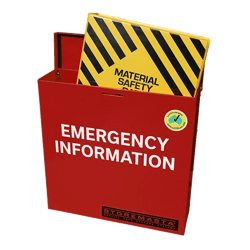 Records, manifests, site emergency plans, and safety data sheets (SDSs) can be safely stored in a Hazmat Box
Records, manifests, site emergency plans, and safety data sheets (SDSs) can be safely stored in a Hazmat Box
Class 1 Emergency Procedures for Fire
Fire and external magazines present a considerable risk to both site personnel and firefighters, so firefighters will not generally engage with the fire directly until safe to do so.
People must be evacuated from the vicinity of the store being threatened with fire or currently on fire, and the person in charge of the magazine (if practicable) should liaise with the firefighters and develop an appropriate fire emergency plan.
This fire emergency plan should include:
- The location of the record documentation (or manifest)
- An up-to-date record of the type and quantity of Class 1 explosive substances and articles in storage
- A site plan showing access to the magazine
- Contact information of the person in charge of the magazine
- The location of fire hydrants and fire installations, electrical isolation board, and other dangerous goods kept on site
Next Steps
Dangerous goods storage specialists STOREMASTA can help you implement a Class 1 Explosives storage solution that complies with Australian standards and legislation.
Ask STOREMASTA today about a workplace compliance audit and risk assessment, or virtual dangerous goods training for your personnel.
Joining the team as a Dangerous Goods Storage Consultant, Melissa Hampton became Storemasta's Marketing Manager in late 2021. With extensive knowledge and experience in chemical compliance, Melissa is responsible for leading the Marketing team and helping shape their marketing strategy. In her spare time, you can find Melissa hiking, swimming and enjoying the great outdoors in beautiful north-west Tasmania.
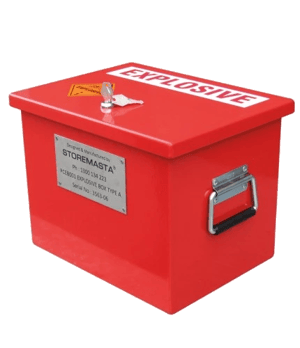



.png?width=150&name=blog-2-new-image3%20(2).png)

.png?width=101&name=new-blog-image5%20(1).png)
.png?width=101&name=new-blog-image6%20(1).png)
